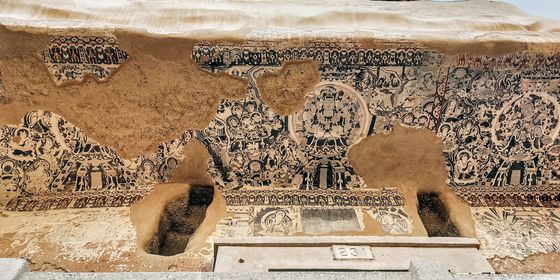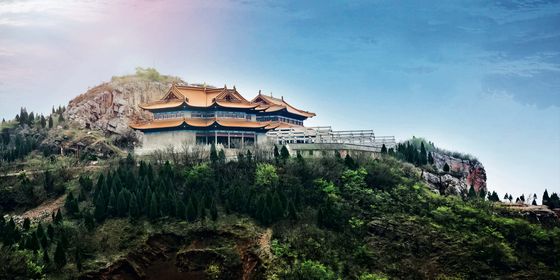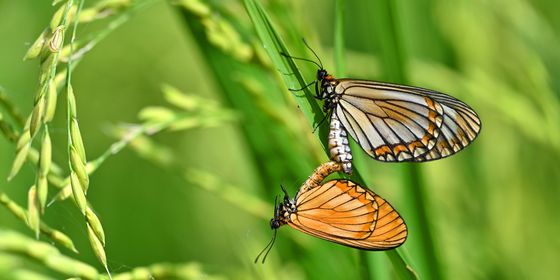How a culinary import responds to local culture
In an age-old debate, the consensus appears to be that cakes have no precise culinary definition, just breads conditioned by extra air bubbles and one’s own cultural expectations for how desserts ought to taste. In the case of the nine-inch layer cakes now ubiquitous in bakery shop windows across Chinese cities, this can be a perfect recipe for crossed cultural wires and disappointment.
Consider the appearance of the typical bakery cake—an airy foundation of an oven-baked, eggy concoction coated with a layer of what those in the English-speaking world might naturally consider to be “frosting” or “icing”. Yet the words “frosting” and “icing” definitely recall a texture of crystallized sugar and crunchy glaze that the Chinese bakery cake share neither in composition nor taste. Instead, the Chinese bakery cake is glazed by the even more obviously named naiyou (奶油, “milk oil”): a fluffy mass of cream, vegetable oil-based whipped topping, but only lightly tinged by a sweet taste. They often come topped with fresh fruits but the creamy glaze can dry up or break down after an hour or so left in the open air. Underneath, the base is typically a sponge cake held up by beaten egg whites and filled with more cream and fruit.
Next to similarly tiered-and-glazed Western staples like the German chocolate cake or Boston cream pie or the basic buttercream sheet cake, it’s no wonder the strangeness of Chinese cake and dessert is a perennial topic on expat blogs. Meanwhile, online baking and decorating communities see routine calls from overseas Chinese and the cake decorators they hire for recipes clarifying that it is the elusive cake of their childhoods that they want, not that American stuff.
On the flip side, hordes of Chinese diners who encounter actual sugar-based frosting or icing, classic pound cake, custard, and chocolate-cream fillings, have had a one-word response to these Western culinary staples: ni (腻), which is not a bad British movie reference but a difficult-to-translate word that means feeling sick from over-exposure to one taste. In the case of “Western desserts”, or xidian, they usually mean that the dessert is too sweet, or 甜腻, though sometimes they are also considered too oily or rich, or 油腻. Whether your preferred poison is marzipan or meringue, fondant or the typical American buttercream, naiyou remains several magnitudes lighter and blander than all of these; the tartness of fruit also breaks up the monotony of grease and sugar.
A Chinese fan of TLC’s Cake Boss, who took it upon herself to personally go sample Buddy Valastro’s creations, made up this memorable summary of the experience in a web forum: “Ate some, wasn’t good, everything was overly sweet, but foreigners like it pretty well.”
Stereotyped as a nation of rice-eaters, it can be easy to forget that wheat-based foods and desserts have their own indigenous roots in China. In ancient times, the Silk Roads and maritime trading routes across Asia did brisk trade in desserts such as baklava and ingredients like nuts, dried fruits, almond paste, and eventually sugar cane and vanilla. However, globally, the concept of “cake” as a flour-based concoction made with refined sugar and raised by beaten eggs, rather than unleavened or raised by yeast, was associated with Europe toward the mid-17th century, doubtlessly helped by the large-scale cultivation of sugar cane in the New World colonies. This history is reflected in the names of the culinary certificates at places like the Beijing New East Cuisine School; mastering wheat-flour creations like 饼 (bǐng) makes you an expert at “Chinese-style flour-based snacks (中式面点),” but knowledge about making and decorating cake falls under the curriculum of “Western-style flour-based snacks” (西式面点) or simply “Western snacks” (西点).
The earliest and clearest genealogy of a European-influenced style of sponge cake becoming an East Asian dessert tradition belongs to the Japanese castella. Brought to Japan by Portuguese merchants in the sixteenth century, this is a honey-flavored cake raised by egg whites without the aid of butter or other oil.
It is less clear when the European-influenced cake made landfall in China. According to the court writings of the Qing Dynasty, Qianlong Emperor and Cixi Emperess were both reportedly fond of a snack called 槽子糕 (cáozigāo), a small round cake specially baked for breakfasts in the imperial court out of fresh eggs, white sugar and flour. So called because 蛋 was inauspiciously associated with curses and insults in the imperial capital, the character 槽 (mould) referred to the instrument for baking the cake, and it is now considered a local delicacy in Beijing and Tianjin.
References to Western-style restaurants in Chinese cities and European-inspired desserts being consumed by the elite classes in the imperial capital can also be found in the Qing Dynasty writings such as Qing Records of Petty Matters and Record of the Awakened Garden, the latter of which contains a section of recipes on preparing the most fashionable desserts and confections of the mid-18th century. The Qing Records of Petty Matters tells us that by at least the 19th century Western desserts had become commonplace enough in China to be grouped into five categories: meringues, “wet” desserts (such as ice cream), bread, crispy pastries such as cookies, and cake. The cake is said to be a type of “cream cake” that tastes “soft and spongy”.
In terms of taste, texture, and the method of preparation, cakes in China appeared to have already developed a style of their own by the 18th century. In the Record of the Awakened Garden, compiled in 1782, the primary mode of cooking both egg-based dangao and “Western cake” was by steaming. This would have provided a softer, airier and moist texture to an otherwise familiar set of steps to a modern-day baker, calling for a ratio of a pound of flour, 10 eggs, and half-pound of white sugar evenly mixed and set to rise, then steamed until “chopsticks can be inserted without sticking” and served once it is “cooled and cut in slices”. Those making the “egg-based cake” also have the option of making a “dry cake” by warming up the mixture on a stove before baking in a small metal furnace. The “Western cake” in the 18th-century China called for 16 eggs for every pound of flour and half pound of white sugar, as well as half a bowl of sweet rice wine (酒酿 jiǔniàng) and water. After “mixing by using chopsticks” and “blowing away the foam”, the batter must be left somewhere warm to rise, and then wrapped securely in cloth before being placed in a bamboo steamer.
The commercial bakery offering Western-inspired birthday cakes, danishes, shortbreads, and other pastries had their start in the 1980s and 90s on the Chinese mainland, helped by market reform as well as the techniques and adaptations for taste developed by bakeries in Hong Kong. Well-known Chinese bakery chains such as Holiland and Christine were both founded in 1992, later joined by chains such as Weidome, Auspicious Phoenix, Ichido, and Kengee. It was also around this time that it became tradition in China to serve cake at birthday celebrations, which were and still are partly associated with foods such as noodles symbolizing longevity and boiled egg, symbolizing “rollover onto the next year”.
Today, however, the fruit-and-naiyou bakery cake is more or less referred to by default with the term “birthday cake”, while more elaborate, artistic, fondant-based cakes for weddings and expositions tend to be the job of boutique bakeries and specialty chains such as Black Swan rather than the commercial bakery. If the search results of group-buying sites are any indication, in more recent years mousse cakes featuring stencilled-on astrological signs are becoming the trendy option in birthday cakes. The absence of ovens in most Chinese homes makes DIY cake-decorating sessions a popular offering at commercial bakeries as a birthday treat for one’s children and friends.
The icing vs. naiyou distinction aside, another point of departure between the English and Chinese language of cakes is that a cake in Chinese is not a cake until it is properly garbed. The early example from the Qing records aside, the modern word dangao refers usually to the final product on the shelf once it is coated in naiyou and decorated, while the part that comes out of the oven is more accurately the pizi (坯子, base) or dangao pi (蛋糕坯, cake base), not to be sold or consumed separately. The difference in the texture of naiyou and sugar-based icing leads to several unique cake-decorating techniques and patterns found among Chinese bakeries. Although cream is less stable and breaks down more quickly than sugar-based icing, a skilled decorator will be able to pipe the same types of decoration with the same level of intricacy. However, the lines, borders, and the edges of flower petals made with naiyou are noticeably smoother and shinier, with a rounded and flowing appearance compared to the jagged and stiff textures of icing or fondant. The fruit or chocolate garnishes can also be cut and arranged into creative patterns to give a vertical dimension to the cake.
The 12 animals of the Chinese zodiac, the red-tipped “longevity peach” (寿桃 shòutáo), mah-jong pieces, and the bearded “old sage of longevity” (老寿星 lǎoshòuxing) are staple Chinese decoration on birthday cakes. These can be piped directly onto the cake using cream as three-dimensional figures, which, according to the evaluation forms for job applicants at the popular chain bakery Auspicious Phoenix, is a required skill for their decorators. To make a bearded sage, which is a common motif used in birthday cakes for the elderly, the decorator puts a wide-tipped piping bag close to the surface of a cake and slowly builds the feet, body and eventually the head by squeezing in a circular motion, then smoothing the figure an adding details with a small brush. The hair and beard are then piped onto the body with a small parchment bag, with the silky texture of the naiyou giving complement to the mystical, flowing hair and robes of the old immortal. Alternatively, the pizi might be cut into small pieces that are then used to make the base of a three-dimensional figure, or else the figure might be pre-made out of chocolate, as is common for mah-jong-piece decorations.
Due perhaps to the sensitivity of naiyou to room temperature and heat from the decorator’s hands, typical cream-based Chinese bakery cake decorations are meant to be completed in a short amount of time. Provided you don’t visit at a busy time or with an abnormally complicated order, you can walk into most bakeries in China and leave with your decorated birthday cake in 15 minutes or less. Online tutorials for making three-dimensional cake decorations usually clock in at five to ten minutes even including explanations. There is also a sub-genre of videos, aimed at professional and amateur decorators, where the appeal seems to at least partly be watching the decorator pipe the most complicated figure in as short a time as possible, usually one to two minutes. TLC has got some competition.
“The Anatomy of Cake” is a story from our issue, “Agriculture”. To read the entire issue, become a subscriber and receive the full magazine. Alternatively, you can purchase the digital version from the iTunes Store.












